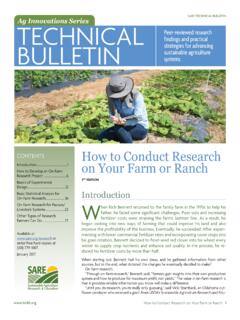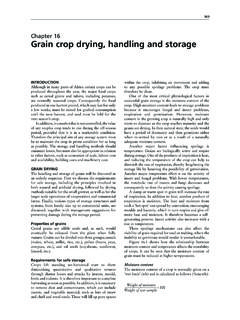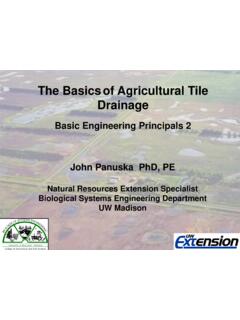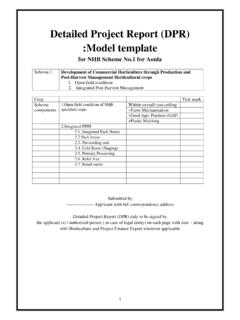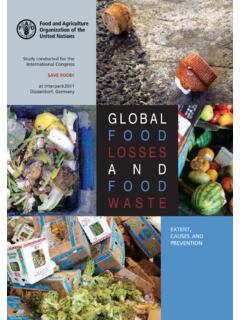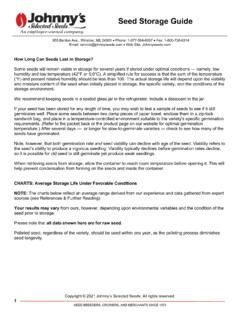Transcription of Managing Cover Crops Profitably - SARE
1 USDA Plant Hardiness Zone MapAgricultural Research Service USDAM anaging Cover Crops ProfitablyHandbook Series Book 9 Published by the Sustainable Agriculture Research and Education(SARE) program, with funding from the National Institute ofFood and Agriculture, Department of AgricultureTHIRD EDITIONT hird Printing - June 2012 Managing Cover Crops Profitably , Third Edition, was pub-lished in 2007 by the Sustainable Agriculture Research andEducation (SARE) program under cooperative agreementswith the National Institute of Food and Agriculture, USDA,the University of Maryland and the University of Vermont. Every effort has been made to make this book as accurate aspossible and to educate the reader. This text is only a guide,however, and should be used in conjunction with other infor-mation sources on farm management. No single Cover cropmanagement strategy will be appropriate and effective for allconditions. The editor/authors and publisher disclaim any lia-bility, loss or risk, personal or otherwise, which is incurred asa consequence, directly or indirectly, of the use and applica-tion of any of the contents of this , visual representation or inferred reference of aproduct, service, manufacturer or organization in this publi-cation does not imply endorsement by the USDA, the SARE program or the authors.
2 Exclusion does not imply a works to increase knowledge about and help farmersand ranchers adopt practices that are profitable, environ-mentally sound and good for communities. For more informa-tion about SARE grant opportunities and informationalresources, go to SARE Outreach is the nationaloutreach arm of SARE. For more information, contact:SARE Outreach1122 Patapsco BuildingUniversity of MarylandCollege Park, MD 20742-6715(301) 405-8020(301) 405-7711 order copies of this book, ($ plus $ s/h) contact (301) 374-9696, or order online manager and editor: Andy ClarkGraphic design and layout: Diane BuricInterior illustrations: Marianne Sarrantonio and Elayne SearsCopy editing: Andy ClarkProofreading: Aneeqa ChowdhuryIndexing: Claire BrannenPrinting: United Book Press, of Congress Cataloging-in-Publication DataManaging Cover Crops Profitably / project manager and editor,Andy Clark. 3rd cm. -- (Sustainable Agriculture Research and Education(SARE) program handbook series ; bk.)
3 9)Includes bibliographical references and 978-1-888626-12-4 (pbk.)1. Cover Crops United States Handbooks, manuals, Clark,Andy. II. Sustainable Agriculture Research &Education (SARE) '82 dc222007024273 Cover photos(clockwise from top left):Jeff Moyer, farm manager for The Rodale Institute, kills a hairyvetch Cover crop with a newly designed, front-mountedroller while a no-till planter drops seed corn behind the tractor. Photo by Matthew Ryan for the Rodale ryegrass overseeded into kale is already providingcover crop benefits before cash crop harvest. Photo by Vern Grubinger, Univ. of Chen, a Univ. of MD graduate student, studies the ability of forage radish to alleviate soil compaction. Photo byRay Weil, Univ. of winter smother crop of yellow mustard minimizes weedgrowth in a vineyard. Photo by Jack Kelly Clark, Univ. of CA. Purple Bounty hairy vetch, an early-maturing, winter hardyvariety for the Northeast, was developed by Dr. Tom Devine,USDA-ARS in collaboration with The Rodale Institute,Pennsylvania State University and Cornell UniversityAgricultural Experiment Stations.
4 Photo by Greg Bowman, clover, frostseeded into winter wheat, is well establishedjust prior to wheat harvest. Photo by Steve Deming, MSU Kellogg Biological Cover photo:Sorghum-sudangrass increased irrigatedpotato yield and tuber quality in Colorado, whether it washarvested for hay or incorporated prior to potato by Jorge A. Delgado, in the United States of America on recycled Crops slow erosion, improve soil,smother weeds, enhance nutrient andmoisture availability, help control manypests and bring a host of other benefits to yourfarm. At the same time, they can reduce costs,increase profits and even create new sources ofincome. You ll reap dividends on your Cover cropinvestments for years, because their benefits accu -mulate over the long term. Increasing energy costs will have a profoundeffect on farm economics in coming years. As wego to press, it is impossible to predict how fastenergy costs will increase, but since Cover cropeconomics are rooted in nitrogen dynamics (howmuch N you save or produce with Cover Crops ),fuel costs (the cost of N and trips across the field)and commodity prices, energy prices will certain-ly impact the economics of Cover crop use.
5 Economic comparisons in the 2nd edition werebased on the old economy of two-dollar corn,twenty-cent nitrogen and cheap gas. Some studiesshowed that Cover Crops become more profitableas the price of nitrogen increases. We retainedsome of these excellent studies because data fromnew studies is not yet available. What we do knowis that Cover Crops can help you to increase yields,save on nitrogen costs, reduce trips across the fieldand also reap many additional agronomic is a Cover crop to fit just about everyfarming situation. The purpose of this book is tohelp you find which ones are right for you. Farmers around the country are increasinglylooking at the long-term contributions of covercrops to their whole farm system. Some of themost successful are those who have seen the ben-efits and are committed to making Cover cropswork for them. They are re-tooling their croppingsystems to better fit Cover crop growth patterns,rather than squeezing Cover Crops into their exist-ing system, time permitting.
6 This 3rd edition of Managing Cover CropsProfitablyaims to capture farmer and otherresearch results from the past ten years. We verifiedthe information from the 2nd edition, added newresults and updated farmer profiles and researchdata throughout. We also added two new chapters. Brassicas and Mustards(p. 81) lays out thecurrent theory and management of Cover Crops inthe BRASSICACEAE family. Brassica Cover Crops arethought to play a role in management of nema-todes, weeds and disease by releasing chemicalcompounds from decomposing residue. Resultsare promising but inconsistent. Try brassicas onsmall plots and consult local expertise for addi-tional Cover Crops in ConservationTillage Systems(p. 44) addresses the managementcomplexities of reduced tillage systems. If you arealready using Cover Crops , the chapter will helpyou reduce tillage. If you are already using con-servation tillage, it shows you how to add or bet-ter manage Cover Crops . Cover Crops andconservation tillage team up to reduce energy useon your farm and that means more profits.
7 We have tried to include enough informationfor you to select and use Cover Crops appropriateto your operation. We recommend that you defineyour reasons for growing a Cover crop the sec -tion, Selecting the Best Cover Crops for YourFarm(p. 12) can help with this and take asmuch care in selecting and Managing Cover cropsas you would a cash crop. Regional and site-specific factors can compli catecover crop management. No book can ade quatelyaddress all the variables that make up a crop pro-duction system. Before planting a Cover crop, learnas much as you can from this book and talk to oth-ers who are experienced with that Cover hope that this updated and expand ed edi-tion of Managing Cover Crops Profitablywilllead to the successful use of Cover Crops on awider scale as we continue to increase the sus-tainability of our farming systems. Andy Clark, Communications Director Sustainable Agriculture Research andEducation (SARE)June, 2007 FOREWORD4 Managing Cover Crops PROFITABLYMANAGING Cover Crops PROFITABLYTHIRD EDITIONF oreword.
8 3 Acknowledgments.. 5 How to Use this Book .. 7 Benefits of Cover Crops .. 9 Selecting the Best Cover Crops for Your Farm.. 12 Building Soil Fertility and Tilth with Cover Crops .. 16 Cover Crops Can Stabilize Your Soil.. 19 How Much N? .. 22 Managing Pests with Cover Crops .. 25 Georgia Cotton, Peanut Farmers Use Cover Crops to Control Pests .. 26 Select Covers that Balance Pests, Problems of Farm.. 30 Crop Rotations with Cover Crops .. 34 Full-Year Covers Tackle Tough Weeds .. 38 Start Where You Are.. 41 Managing Cover Crops in Conservation Tillage Systems.. 44 After 25 Years, Improvements Keep Coming .. 52 Introduction to Charts.. 62 Chart 1: Top Regional Cover Crop Species .. 66 Chart 2: Performance and Roles.. 67 Chart 3A: Cultural Traits .. 69 Chart 3B: Planting.. 70 Chart 4A: Potential Advantages.. 71 Chart 4B: Potential .. 72 Cover CROP SPECIESO verview of Nonlegume Cover Crops .. 73 Annual Ryegrass.. 74 Barley.. 77 Brassicas and Mustards .. 81 Mustard Mix Manages Nematodes inPotato/Wheat System.
9 86 Buckwheat.. 90 Oats .. 93 Oats, Rye Feed Soil in Corn/Bean Rotation.. 96 Rye .. 98 Cereal Rye: Cover Crop Workhorse .. 102 Rye Smothers Weeds Before Soybeans . 104 Sorghum Sudangrass Hybrids .. 106 Summer Covers Relieve Compaction.. 110 Winter Wheat.. 111 Wheat Boosts Income and Soil Protection.. 113 Wheat Offers High-VolumeWeed Control Too .. 114 Overview of Legume Cover Crops .. 116 Cover Crop Mixtures Expand Possibilities.. 117 Berseem Clover .. 118 Nodulation: Match Inoculant to Maximize N.. 122 Cowpeas .. 125 Cowpeas Provide Elegant Solution to Awkward Niche .. 128 Crimson Clover .. 130 Field Peas .. 135 Peas Do Double Duty for Kansas Farmer .. 140 Hairy Vetch.. 142 Cover Crop Roller Design Holds Promise for No-Tillers.. 146 Vetch Beats Plastic .. 150 Medics .. 152 Jess Counts on GEORGEfor N and Feed.. 153 Southern Spotted Bur Medic offersReseeding Persistence.. 154 ACKNOWLEDGMENTS5 This 3rd edition could not have been written without the help of many Cover crop experts.
10 It isbased in large part on the content of the 2nd edition, researched and written by Greg Bowman,Craig Cramer and Christopher Shirley. The following people reviewed the 2nd edition, suggestedrevisions and updates and contributed new content. Aref Abdul-Baki, retired, USDA-ARSW esley Adams, Ladonia, TXKenneth A. Albrecht, Univ. of WisconsinJess Alger, Stanford, MTRobert G. Bailey, USDA Forest ServiceKipling Balkcom, USDA-ARSR onnie Barentine, Univ. of GeorgiaPhil Bauer, USDA-ARSR. Louis Baumhardt, USDA-ARSRich and Nancy Bennett, Napoleon, OHValerie Berton, SARER obert Blackshaw, Agriculture and Agri-Food CanadaGreg Bowman, NewFarmRick Boydston, USDA-ARSLois Braun, Univ. of MinnesotaEric B. Brennan, USDA-ARSPat Carr, North Dakota State Carter, Douglas, GAGuihua Chen, Univ. of MarylandAneeqa Chowdhury, SAREHal Collins, USDA-ARSC raig Cramer, Cornell Creamer, North Carolina State S. Curran, The Pennsylvania State Dabney, USDA-ARSB ryan Davis, Grinnell, IA Jorge Delgado, USDA-ARSJuan Carlos Diaz-Perez, Univ.
